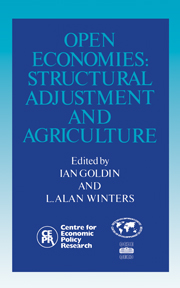Book contents
- Frontmatter
- Contents
- List of figures
- List of tables
- Preface
- Acknowledgements
- List of conference participants
- 1 Introduction: from macro to maize
- Part One Open economy analysis
- Part Two The small country assumption and trade reform
- 6 Exchange reforms, supply response, and inflation in Africa
- Discussion
- 7 Taxes versus quotas: the case of cocoa exports
- Discussion
- 8 Trade reform and the small country assumption
- Discussion
- Part Three Risk and adjustment
- Part Four Government's role
- Index
6 - Exchange reforms, supply response, and inflation in Africa
from Part Two - The small country assumption and trade reform
Published online by Cambridge University Press: 04 August 2010
- Frontmatter
- Contents
- List of figures
- List of tables
- Preface
- Acknowledgements
- List of conference participants
- 1 Introduction: from macro to maize
- Part One Open economy analysis
- Part Two The small country assumption and trade reform
- 6 Exchange reforms, supply response, and inflation in Africa
- Discussion
- 7 Taxes versus quotas: the case of cocoa exports
- Discussion
- 8 Trade reform and the small country assumption
- Discussion
- Part Three Risk and adjustment
- Part Four Government's role
- Index
Summary
Introduction
A central element of reform programmes in sub-Saharan Africa (SSA) has been the realignment of exchange rates. Other than in the CFA Zone the extent of exchange rate reforms has been very widespread in Africa. Almost every country in SSA outside the CFA Zone has undergone substantial exchange rate devaluation. During the period 1984-9 exchange rate reforms were undertaken in 18 countries in the continent. Of these 10 countries experienced devaluations of 10 per cent or more each year from 1984 to 1989. It is alleged that the introduction of such programmes has led to cost-push inflation. Without sufficient supply response (and export response) these devaluations have had little positive real effects, while generating higher inflation. Concern over the inflationary consequences of reform and the lack of supply response have led several countries to delay, and in a few cases to abort, reform programmes. The relatively low inflation in the CFA Zone countries in Africa has lent credence to these arguments. It is widely believed that the fixed exchange rate for the CFA Zone countries has been an important factor in their low inflation rates (see Chapter 4 for an explanation of the CFA Zone's genesis).
This paper focuses on the issue of the inflationary consequences of exchange rate reforms and accompanying price liberalisation. The paper reports on the major findings of a research project carried out at the World Bank on this subject, and places these findings in the context of existing literature on the subject. The paper does not go into other important issues related to the pace of the exchange rate reforms, the politics of reform, and questions dealing with the distributional consequences of reform.
- Type
- Chapter
- Information
- Open EconomiesStructural Adjustment and Agriculture, pp. 125 - 144Publisher: Cambridge University PressPrint publication year: 1992
- 2
- Cited by



